Search Result
Results for "
nAChR Antagonist
" in MedChemExpress (MCE) Product Catalog:
2
Isotope-Labeled Compounds
| Cat. No. |
Product Name |
Target |
Research Areas |
Chemical Structure |
-
- HY-146405
-
|
|
nAChR
|
Neurological Disease
Inflammation/Immunology
|
|
nAChR antagonist 1 (compound B15) is an excellent α7 nAChR antagonist with an IC50 value of 3.3 μM. nAChR antagonist 1 can be used for researching schizophrenia, Alzheimer’s disease and inflammatory disorders .
|
-
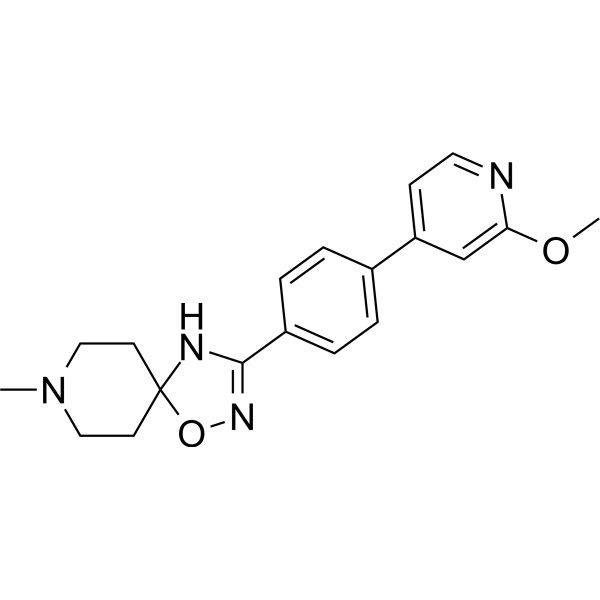
-
- HY-P5188A
-
-

-
- HY-P1265
-
|
Vc1.1
|
nAChR
|
Neurological Disease
|
|
ACV1 (Vc1.1), an α-Conotoxin, is a selective α9α10 nAChR antagonist with an IC50 of 19 nM. ACV1 is ~100-fold less potent on human α9α10 vs. rat nAChRs .
|
-
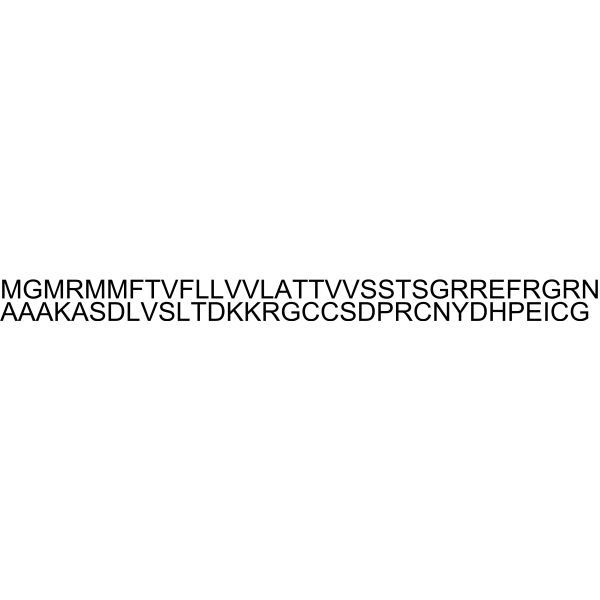
-
- HY-N10132
-
|
|
nAChR
|
Infection
Neurological Disease
|
|
Microgrewiapine A is an antagonist of nAChR. Microgrewiapine A inhibits hα4β2 and hα3β4 activity with 60% and 70% inhibition, respectively. Microgrewiapine A has selective cytotoxic against HT-29 human colon cancer cells with an IC50 of 6.8 μM .
|
-

-
- HY-U00139
-
-
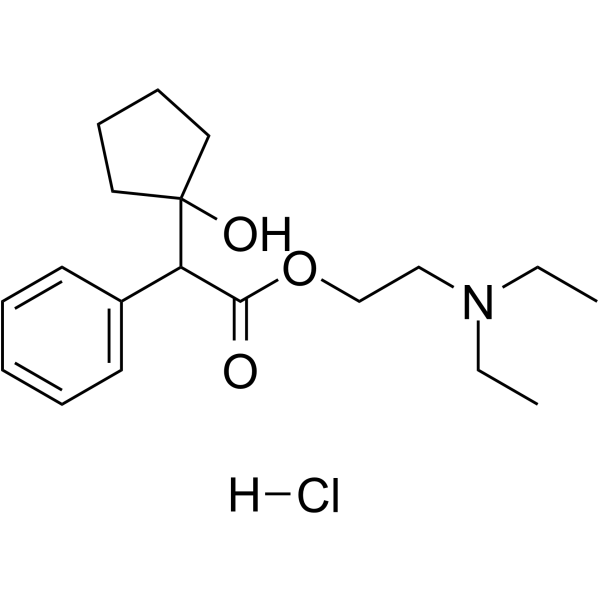
-
- HY-145297
-
-

-
- HY-107672
-
|
Stilonium iodide
|
nAChR
|
Neurological Disease
|
|
MG624 is a potent and selective neuronal α7 nAChR antagonist with a Ki of 106 nM .
|
-
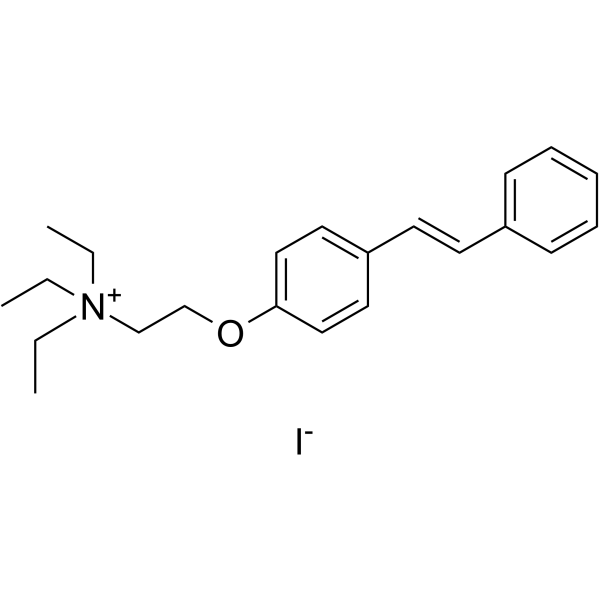
-
- HY-P3654
-
|
|
nAChR
|
Neurological Disease
|
|
α-Conotoxin SIA is a selective nicotinic acetylcholine receptor (nAChR) antagonist with high affinity for the muscle nAChR. α-Conotoxin SIA preferentially targets the α/δ interface of the muscle nAChR in mouse muscle. In contrast, for Torpedo nAChR, α-Conotoxin SIA has a much higher affinity for the α/γ than for the α/δ interface .
|
-

-
- HY-146404
-
-
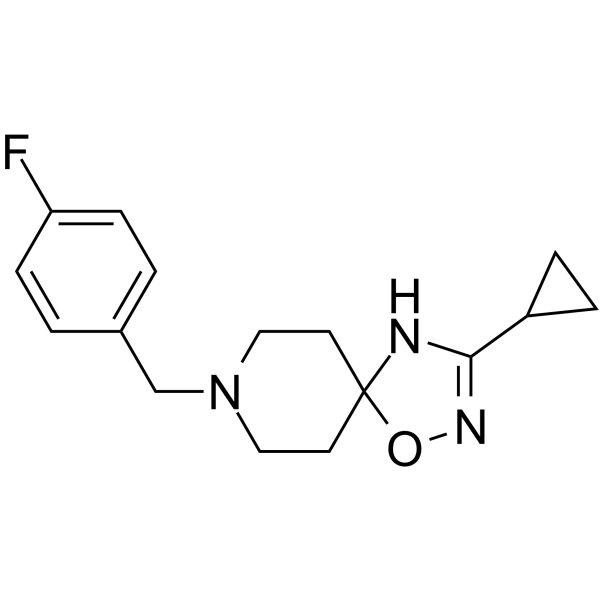
-
- HY-P5849
-
|
αA-OIVA
|
nAChR
|
Neurological Disease
|
|
αA-Conotoxin OIVA (αA-OIVA) is a selective nAChR antagonist with an IC50 of 56 nM against mammalian fetal muscle nAChR. αA-Conotoxin OIVA is a peptide that can be derived from conotoxin. αA-Conotoxin OIVA paralyzes muscles .
|
-
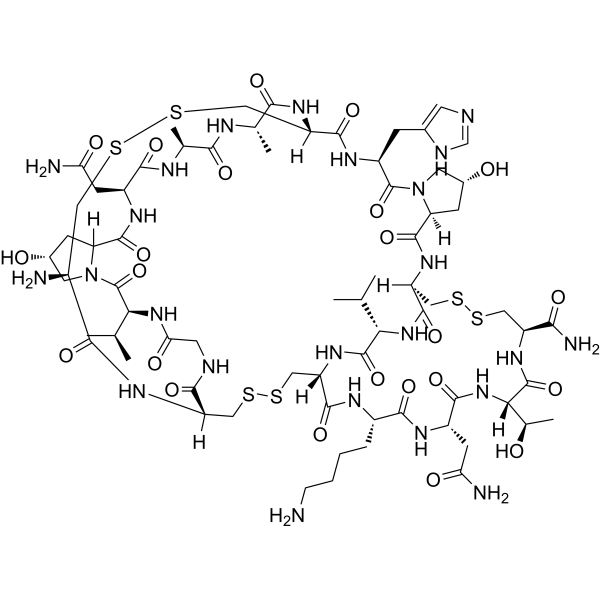
-
- HY-107679
-
-
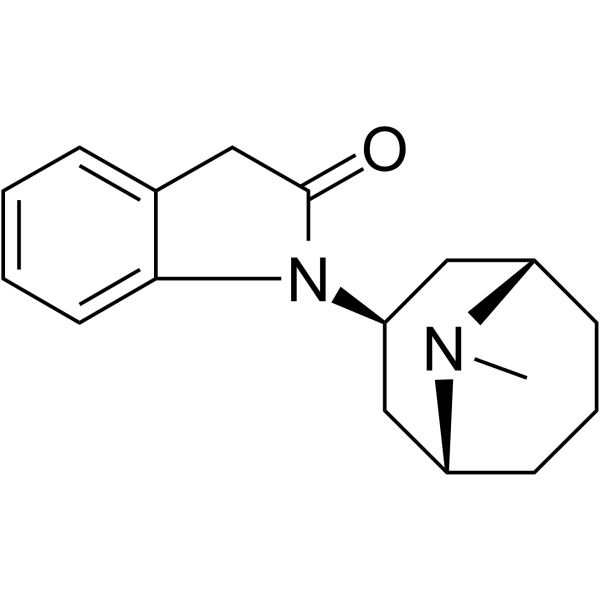
-
- HY-P1269
-
|
|
nAChR
|
Neurological Disease
|
|
α-Conotoxin AuIB, a potent and selective α3β4 nicotinic acetylcholine receptor (nAChR) antagonist, blocks α3β4 nAChRs expressed in Xenopus oocytes with an IC50 of 0.75 μM .
|
-
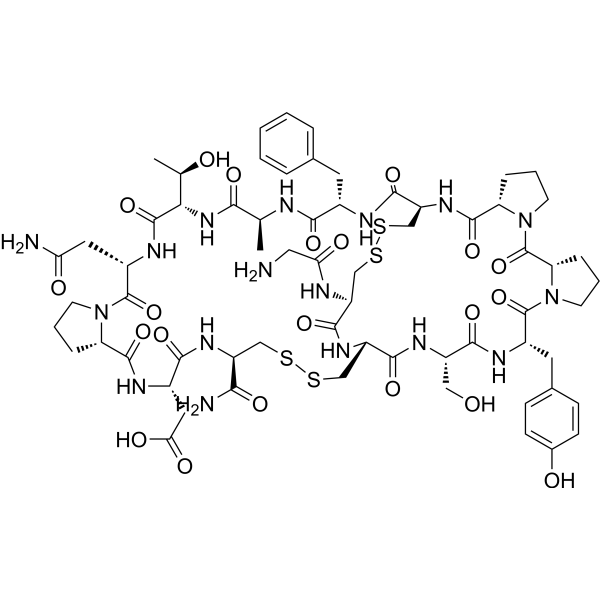
-
- HY-P1268
-
|
|
nAChR
|
Neurological Disease
|
|
α-Conotoxin PIA is a nicotinic acetylcholine receptor (nAChR) antagonist that targets nAChR subtypes containing α6 and α3 subunits. α-Conotoxin PIA has the potential for the research of Parkinson’s disease, and schizophrenia 。
|
-
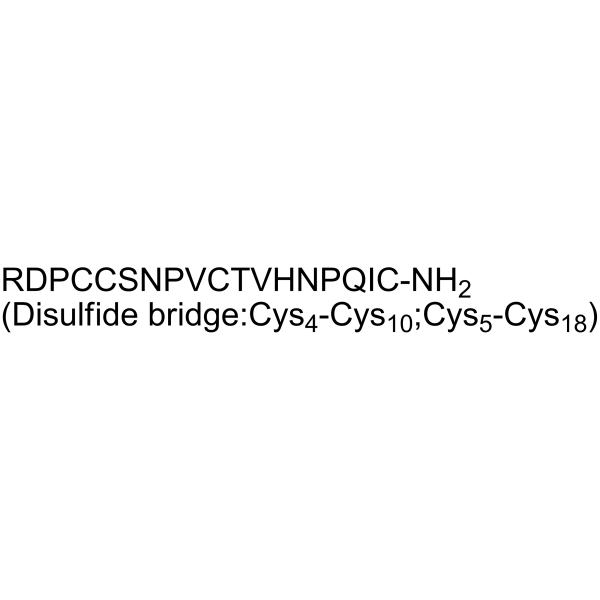
-
- HY-P1269A
-
|
|
nAChR
|
Neurological Disease
|
|
α-Conotoxin AuIB TFA, a potent and selective α3β4 nicotinic acetylcholine receptor (nAChR) antagonist, blocks α3β4 nAChRs expressed in Xenopus oocytes with an IC50 of 0.75 μM .
|
-
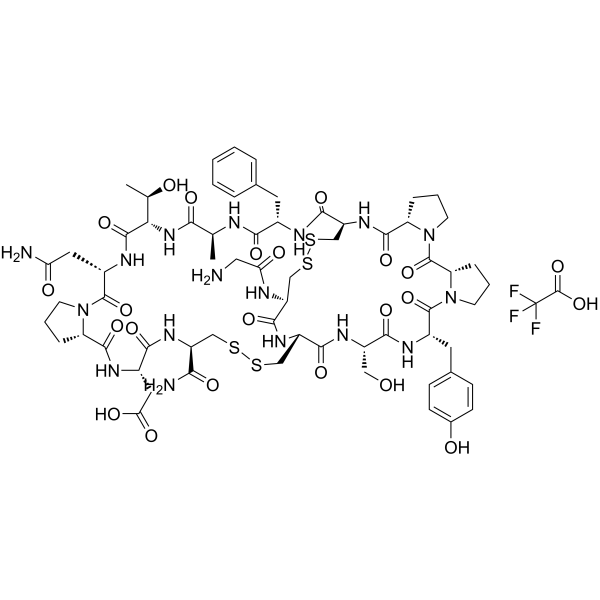
-
- HY-107674
-
|
|
nAChR
|
Neurological Disease
|
|
bPiDDB is a potent nAChR antagonist. bPiDDB potently (IC50=2 nM) inhibits nicotine-evoked striatal dopamine (DA) release through an interaction with α6β2-containing nAChRs .
|
-

-
- HY-P1268A
-
|
|
nAChR
|
Neurological Disease
|
|
α-Conotoxin PIA TFA is a nicotinic acetylcholine receptor (nAChR) antagonist that targets nAChR subtypes containing α6 and α3 subunits. α-Conotoxin PIA has the potential for the research of Parkinson’s disease, and schizophrenia 。
|
-
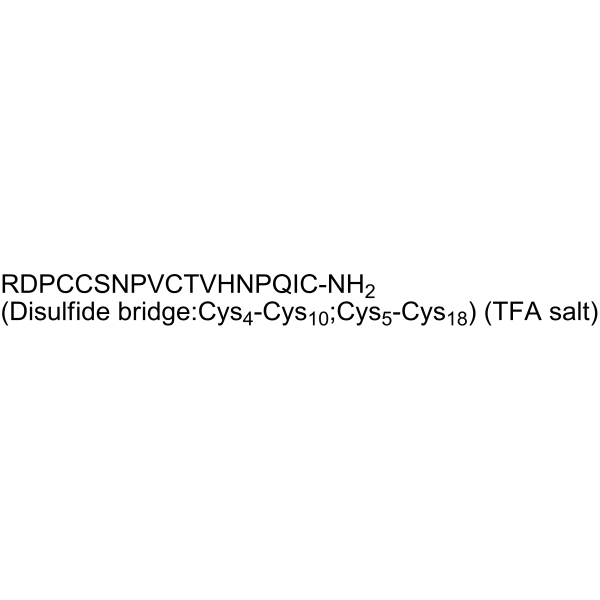
-
- HY-137231B
-
|
|
nAChR
|
Neurological Disease
|
|
(S)-UFR2709 (hydrochloride) is a competitive nAChR antagonist and displays higher affinity for α4β2 nAChRs than for α7 nAChRs. (S)-UFR2709 (hydrochloride) decreases anxiety and reduces ethanol consumption and ethanol preference in alcohol-preferring rats. (S)-UFR2709 (hydrochloride) acts as an anxiolytic agent and can be used for the study of nicotine addiction .
|
-
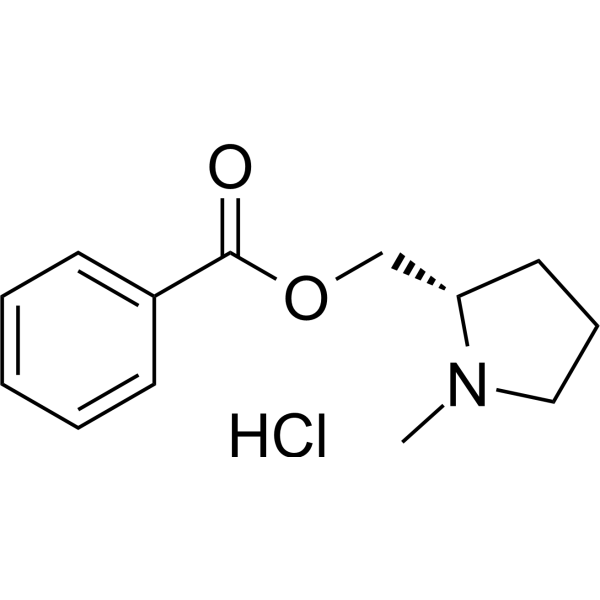
-
- HY-137231A
-
|
|
nAChR
|
Neurological Disease
|
|
(S)-UFR2709 is a competitive nAChR antagonist and displays higher affinity for α4β2 nAChRs than for α7 nAChRs. (S)-UFR2709 decreases anxiety and reduces ethanol consumption and ethanol preference in alcohol-preferring rats. (S)-UFR2709 acts as an anxiolytic agent and can be used for the study of nicotine addiction .
|
-
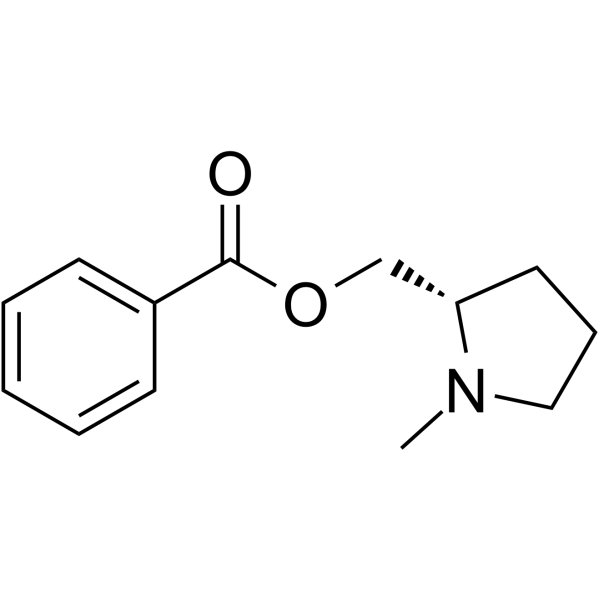
-
- HY-N3610
-
|
|
nAChR
|
Neurological Disease
|
|
Coclaurine is a class of tetrahydroisoquinoline alkaloids that can be isolated from Sarcopetalum harveyanum. Coclaurine is a nicotinic acetylcholine receptor (nAChRs) antagonist .
|
-
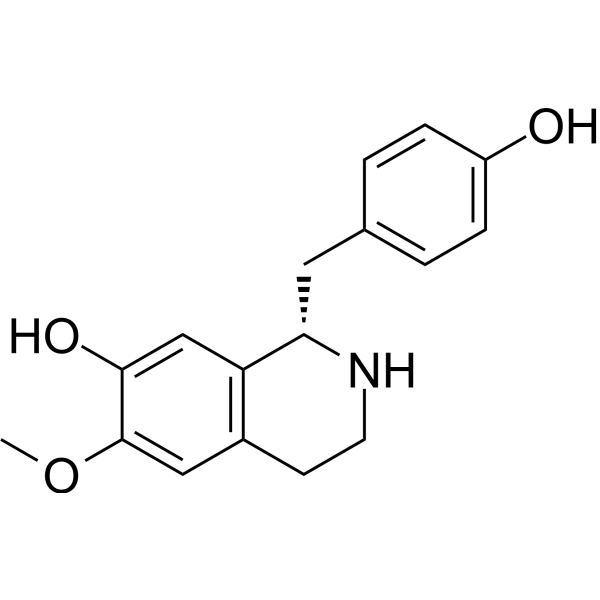
-
- HY-W705106
-
|
(-)-(S)-Coclaurine hydrochloride; (S)-Coclaurine hydrochloride; l-Coclaurine hydrochloride
|
nAChR
|
Neurological Disease
|
|
(-)-Coclaurine hydrochloride (compound I) is a class of tetrahydroisoquinoline alkaloids that can be isolated from Sarcopetalum harveyanum. (-)-Coclaurine hydrochloride is a nicotinic acetylcholine receptor (nAChRs) antagonist .
|
-
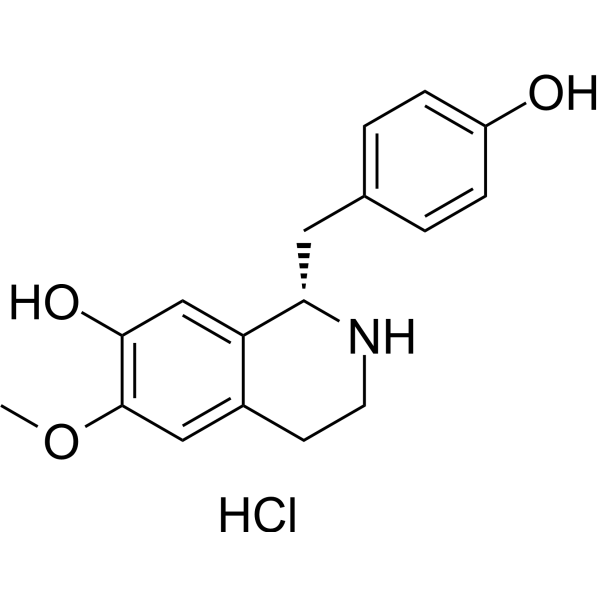
-
- HY-N2332A
-
|
MLA
|
nAChR
|
Neurological Disease
|
|
Methyllycaconitine citrate is a specific antagonist of α7 neuronal nicotinic acetylcholine receptor (α7nAChR) with blood-brain barrier permeability.
|
-
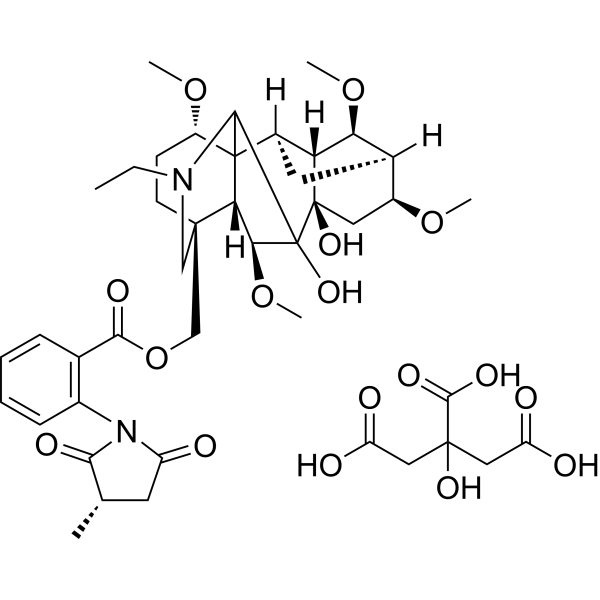
-
- HY-P5149
-
|
αC-PrXA
|
nAChR
|
Neurological Disease
|
|
αC-Conotoxin PrXA is a paralytic peptide neurotoxin and a competitive nAChR antagonist, with IC50s of 1.8 nM (α1β1εδ, adult) and 3.0 nM (α1β1γδ, fetal), respectively. αC-Conotoxin PrXA competes with α-bungarotoxin at the α/δ and α/γ subunit interfaces of the nAChR, shows high specificity against neuromuscular nAChR .
|
-

-
- HY-B1552B
-
|
|
|
|
|
Benzoquinonium dibromide is a nicotinic acetylcholine receptors (nAChRs) antagonist, with an IC50 of 0.46 μM. Benzoquinonium dibromide can block neuromuscular and ganglionic transmission .
|
-
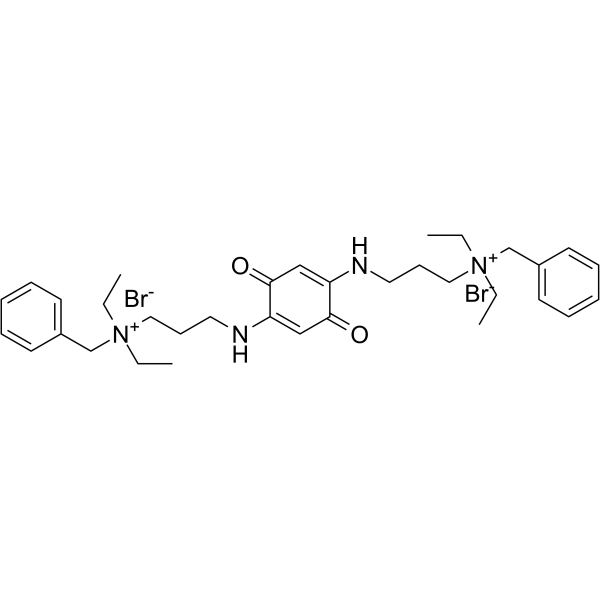
-
- HY-P1264F
-
|
|
nAChR
|
Neurological Disease
|
|
FITC-α-Bungarotoxin is the FITC labelled α-Bungarotoxin (HY-P1264). α-Bungarotoxin is a competitive antagonist at nicotinic acetylcholine receptors (nAChRs) .
|
-

-
- HY-P1264F1
-
|
|
nAChR
|
Neurological Disease
|
|
Biotin-α-Bungarotoxin is the Biotin labelled α-Bungarotoxin (HY-P1264). α-Bungarotoxin is a competitive antagonist at nicotinic acetylcholine receptors (nAChRs) .
|
-

-
- HY-P1267
-
|
|
nAChR
|
Neurological Disease
|
|
α-Conotoxin PnIA, a potent and selective antagonist of the mammalian α7 nAChR, has the potential for the research of neurological conditions such as neuropathic pain and Alzheimer’s disease .
|
-
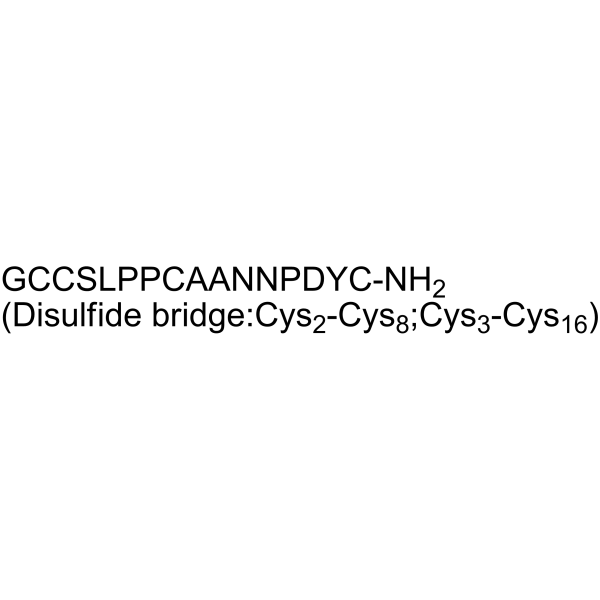
-
- HY-101347
-
|
|
nAChR
|
Neurological Disease
|
|
Chlorisondamine (diiodide) is a potent nicotinic acetylcholine receptor (nAChR) antagonist and a ganglion blocker. Chlorisondamine antagonizes some of nicotine's central actions in a potent, long-lasting and pharmacologically selective way .
|
-
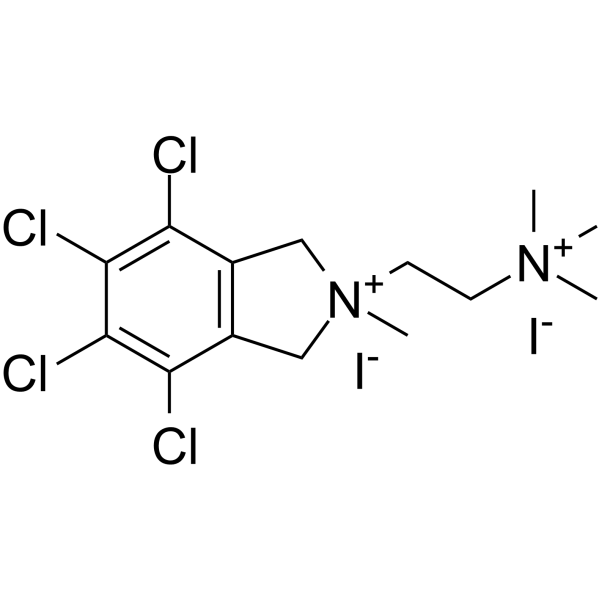
-
- HY-107670
-
|
DHβE hydrobromide
|
nAChR
|
Neurological Disease
|
|
Dihydro-β-erythroidine (DHβE) hydrobromide is a potent, orally active, and competitive antagonist of neuronal nAChRs. Dihydro-β-erythroidine hydrobromide shows selectivity for α4β4 and α4β2 nAChRs, with IC50s of 0.19 and 0.37 μM, respectively. Antidepressant-like activities .
|
-

-
- HY-P1267A
-
|
|
nAChR
|
Neurological Disease
|
|
α-Conotoxin PnIA TFA, a potent and selective antagonist of the mammalian α7 nAChR, has the potential for the research of neurological conditions such as neuropathic pain and Alzheimer’s disease .
|
-
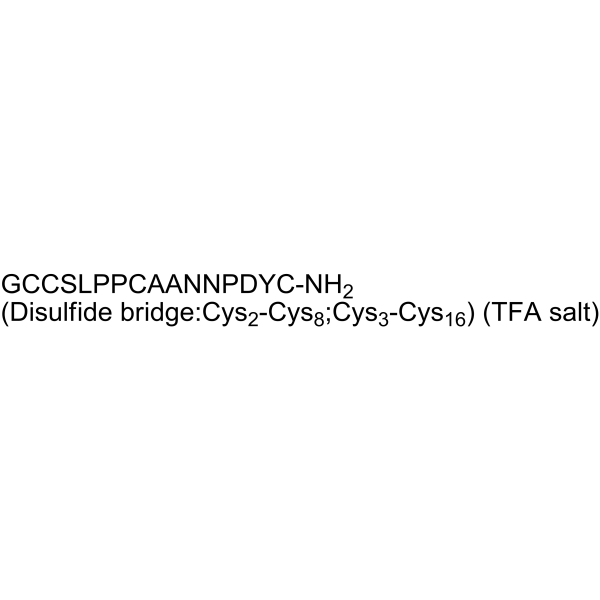
-
- HY-B0569
-
|
|
nAChR
Apoptosis
|
Cardiovascular Disease
Neurological Disease
|
|
Hexamethonium Bromide is a non-selective ganglionic nicotinic-receptor antagonist (nAChR) antagonist, with mixed competitive and noncompetitive activity. Hexamethonium Bromide has anti-hypertensive activity. Hexamethonium Bromide attenuates sympathetic activity and blood pressure in spontaneously hypertensive animal models .
|
-
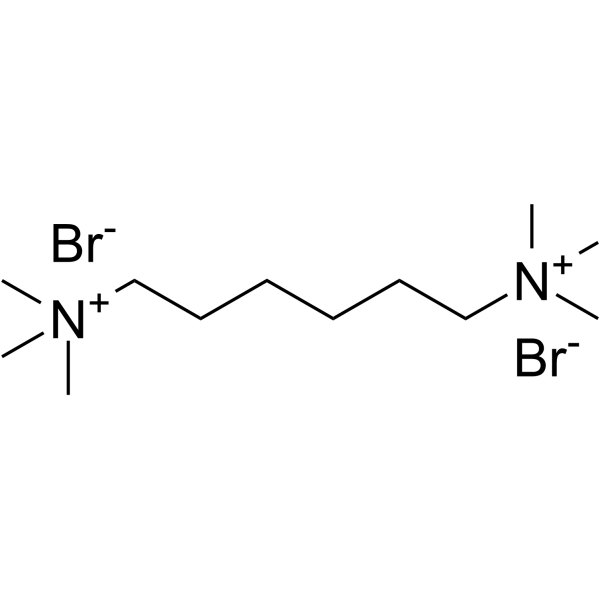
-
- HY-B0743A
-
|
|
nAChR
|
Neurological Disease
|
|
Pipecuronium bromide is a potent long-acting nondepolarizing steroidal neuromuscular blocking agent (NMBA), and a bisquaternary ammonium compound. Pipecuronium bromide is a powerful competitive nAChR antagonist with a Kd of 3.06 μM .
|
-

-
- HY-B1395
-
|
|
|
|
|
Mecamylamine hydrochloride is an orally active, nonselective, noncompetitive nAChR antagonist. Mecamylamine hydrochloride is also a ganglionic blocker. Mecamylamine hydrochloride can across the blood-brain barrier. Mecamylamine hydrochloride can be used in the research of neuropsychiatric disorders, hypertension, antidepressant area .
|
-

-
- HY-P1050
-
|
|
nAChR
|
Neurological Disease
Inflammation/Immunology
|
|
COG 133 is a fragment of Apolipoprotein E (APOE) peptide. COG 133 competes with the ApoE holoprotein for binding the LDL receptor, with potent anti-inflammatory and neuroprotective effects. COG 133 is also a nAChR antagonist with an IC50 of 445 nM .
|
-

-
- HY-108069
-
|
|
Potassium Channel
nAChR
|
Neurological Disease
|
|
Iptakalim hydrochloride, a lipophilic para-amino compound, is a novel ATP-sensitive potassium channel (KATP) opener, as well as an α4β2-containing nicotinic acetylcholine receptor (nAChR) antagonist .
|
-
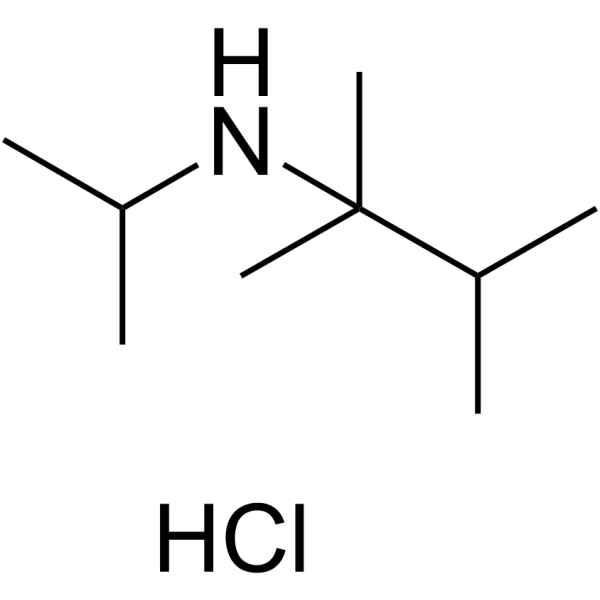
-
- HY-B1395A
-
|
|
nAChR
Histamine Receptor
|
Cardiovascular Disease
Neurological Disease
|
|
Mecamylamine is an orally active, nonselective, noncompetitive nAChR antagonist. Mecamylamine is also a ganglionic blocker. Mecamylamine can across the blood-brain barrier. Mecamylamine can be used in the research of neuropsychiatric disorders, hypertension, antidepressant area .
|
-

-
- HY-P5848
-
|
|
nAChR
|
Neurological Disease
|
|
αO-Conotoxin GeXIVA is a potent α9α10 nAChR antagonist with an IC50 of 12 nM against rat α9α10. αO-Conotoxin GeXIVA shows analgesic in animal models of pain .
|
-
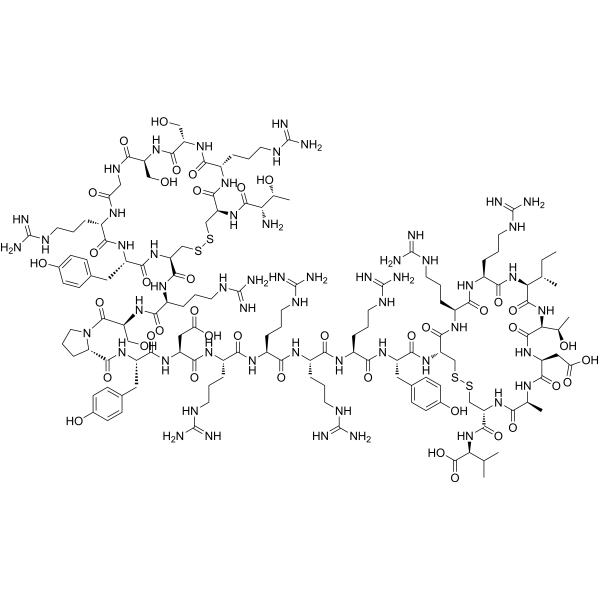
-
- HY-P5306
-
|
|
nAChR
|
Neurological Disease
|
|
α-Conotoxin TxID is a potent α3β4 nAChR antagonist with an IC50 value of 12.5 nM. α-Conotoxin TxID has weak inhibition activity of closely related α6/α3β4 nAChR (IC50= 94 nM). α-Conotoxin TxID has the potential for novel smoking cessation drug development .
|
-

-
- HY-14564A
-
|
DMXB-A; DMBX-anabaseine
|
nAChR
5-HT Receptor
|
Inflammation/Immunology
|
|
GTS-21 dihydrochloride is a selective alpha7 nicotinic acetylcholine receptor (α7-nAChR) agonist with anti‑inflammatory and cognition‑enhancing activities. GTS-21 dihydrochloride is also a α4β2 (Ki=20 nM for humanα4β2) and 5-HT3A receptor (IC50=3.1 μM) antagonist .
|
-
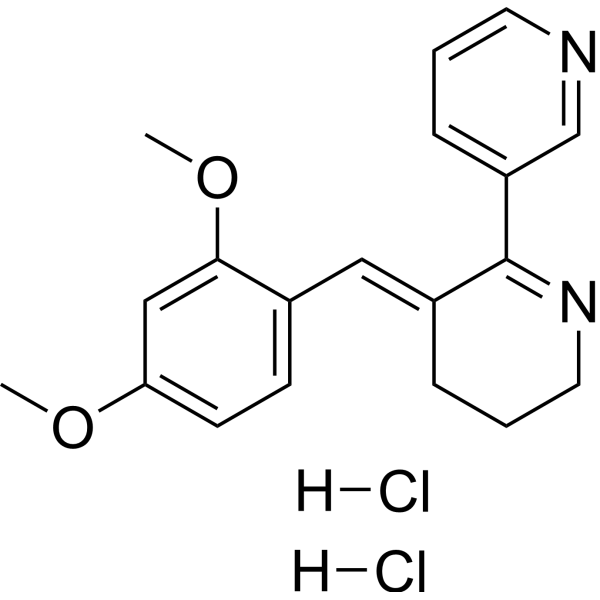
-
- HY-P1271
-
|
|
nAChR
|
Cardiovascular Disease
|
|
Catestatin is a 21-amino acid residue, cationic and hydrophobic peptide. Catestatin is an endogenous peptide that regulates cardiac function and blood pressure . Catestatin is a non-competitive nicotinic antagonist acting through nicotinic acetylcholine receptors (nAChRs) to inhibit catecholamine release .
|
-
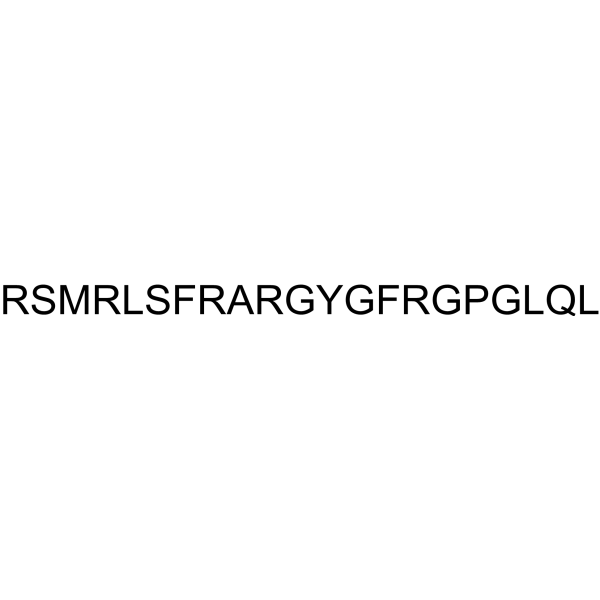
-
- HY-P1050A
-
|
|
nAChR
|
Neurological Disease
Inflammation/Immunology
|
|
COG 133 TFA is a fragment of Apolipoprotein E (APOE) peptide. COG 133 TFA competes with the ApoE holoprotein for binding the LDL receptor, with potent anti-inflammatory and neuroprotective effects. COG 133 TFA is also a nAChR antagonist with an IC50 of 445 nM .
|
-
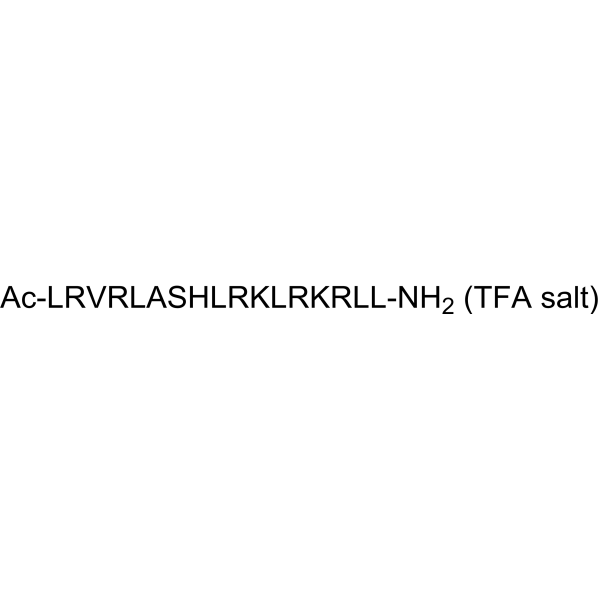
-
- HY-P1270
-
|
|
nAChR
|
Neurological Disease
|
|
α-Conotoxin Im-I is a selective α7/α9 nAChR antagonist, blocking α7 nicotinic receptors with the highest apparent affinity, while having an 8-fold lower affinity for homomeric α9 nicotinic receptors. α-Conotoxin Im-I is toxic and induces seizures in rodents. α-Conotoxin Im-I is a tool for studying neuronal nAChR .
|
-
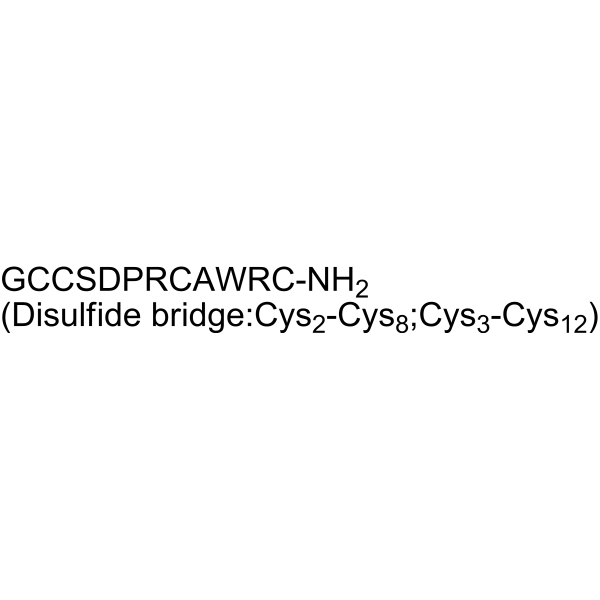
-
- HY-124874
-
|
(rel)-Aspergillimide; (rel)-VM55598
|
nAChR
|
Neurological Disease
|
|
(rel)-Asperparaline A ((rel)-Aspergillimide), an anthelmintic metabolite, is isolated from okara that has been fermented with Aspergillus japonicas JV-23. (rel)-Asperparaline A is also a potent and selective antagonist of nAChR. (rel)-Asperparaline A exhibits paralytic activity in silk worms .
|
-

-
- HY-152170
-
|
|
nAChR
|
Neurological Disease
|
|
bPiDI is a novel selective α6β2 nicotinic receptor antagonist. bPiDI inhibits nicotine-evoked striatal dopamine (DA) release through an interaction with α6β2-containing nAChRs .
|
-
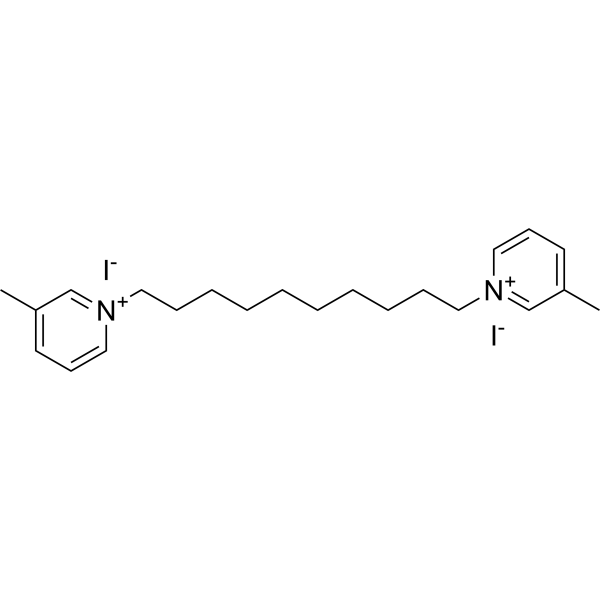
-
- HY-P1271A
-
|
|
nAChR
|
Cardiovascular Disease
|
|
Catestatin TFA is a 21-amino acid residue, cationic and hydrophobic peptide. Catestatin TFA is an endogenous peptide that regulates cardiac function and blood pressure . Catestatin TFA is a non-competitive nicotinic antagonist acting through nicotinic acetylcholine receptors (nAChRs) to inhibit catecholamine release .
|
-
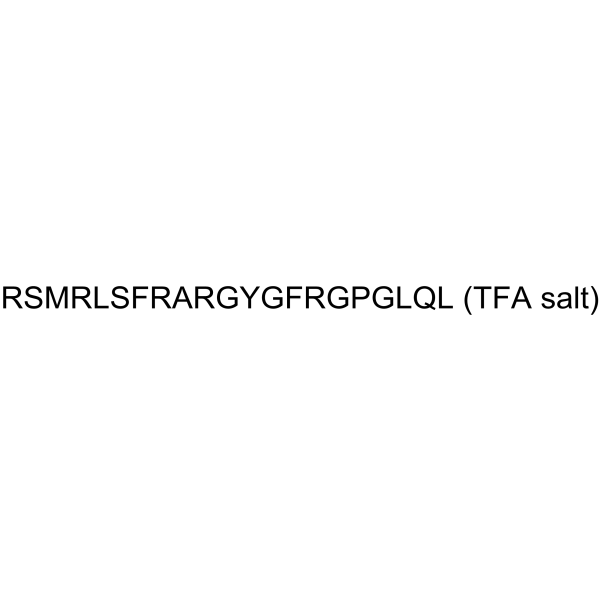
-
- HY-P5845
-
|
α-RgIA
|
nAChR
|
Neurological Disease
|
|
α-Conotoxin RgIA (α-RgIA) is a specific α9α10 nAChR antagonist. α-Conotoxin RgIA can be obtained from Conus regius venom. α-Conotoxin RgIA can be used in the study of neurological diseases .
|
-
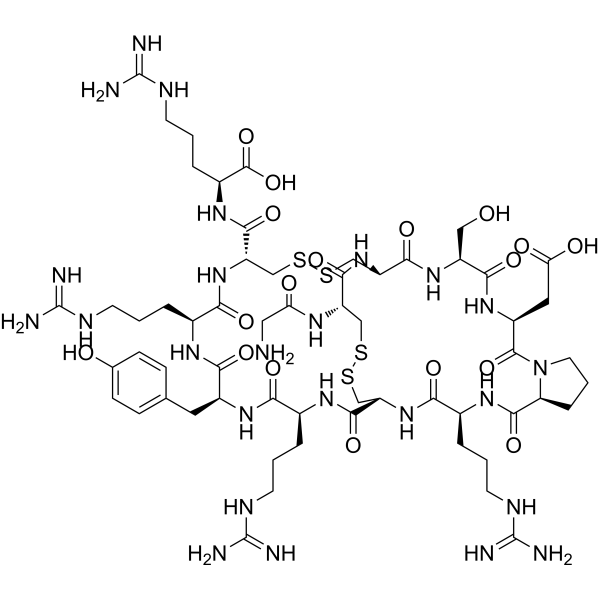
-
- HY-149483
-
|
|
nAChR
|
Neurological Disease
|
|
CVN417 is an orally active α6 subunit-containing nAChR antagonist, modulating phasic dopaminergic neurotransmission in an impulse-dependent manner. CVN417 inhibits Ca(2+) effluents mediated by nAChR subunits with IC50s of 0.086 μM (α6), 2.56 μM (α3) and 0.657 μM (α4), respectively. CVN417 attenuates resting tremor in Rodent models, displays the potential to improve movement dysfunction, in conditions such as Parkinson's disease .
|
-
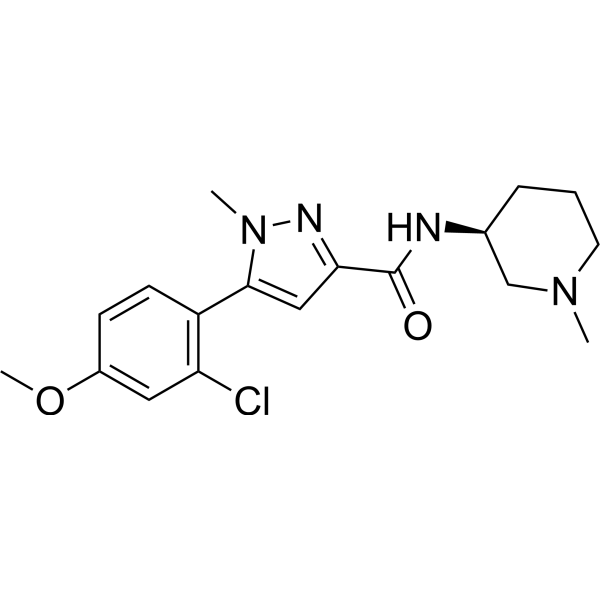
-
- HY-B0567
-
|
|
Potassium Channel
nAChR
Apoptosis
Bacterial
Parasite
|
Infection
Cancer
|
|
Dequalinium chloride is an Apamin (HY-P0256)-sensitive potassium channel selective blocker. Dequalinium chloride is a cationic, lipophilic mitochondrial poison. Dequalinium chloride is also an antagonist pf α7 nAChR, and an anti-microbial antiseptic agent with a broad bactericidal and fungicidal activity .
|
-
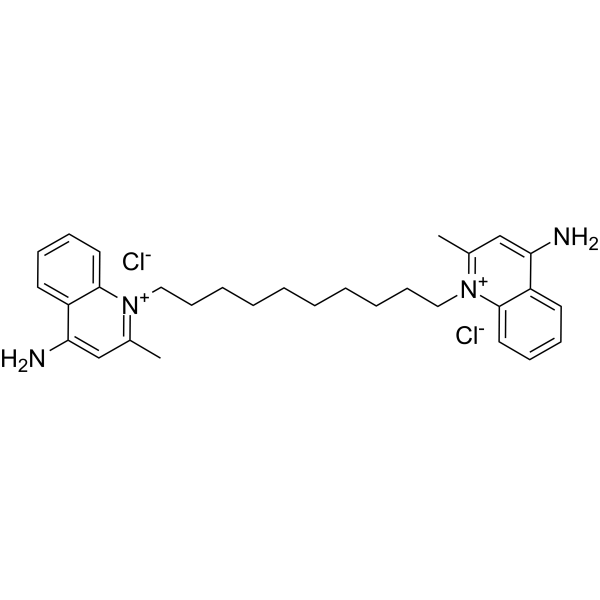
-
- HY-106901A
-
|
HI-6
|
nAChR
|
Neurological Disease
|
|
Asoxime dichloride (HI-6) is an antagonist to acetylcholine receptors (AChRs) including the nicotinic receptor, α7 nAChR. Asoxime dichloride involves in modulating immunity response. Asoxime dichloride (HI-6) can be used as an antigen and improves vaccination efficacy in the nervous system .
|
-
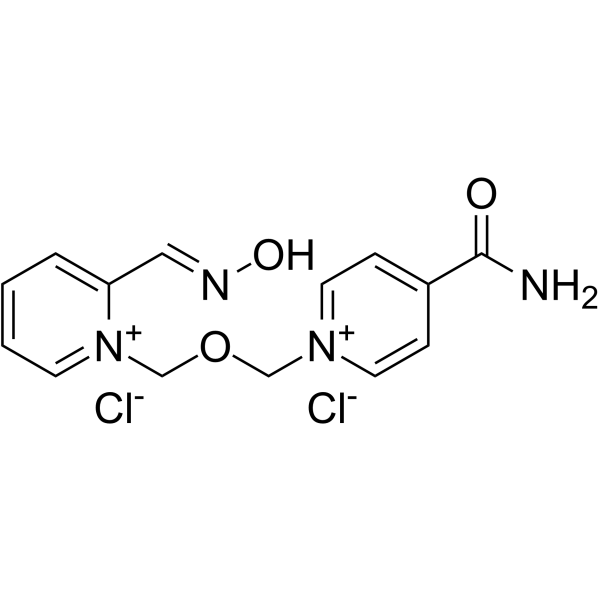
-
- HY-12560A
-
|
|
nAChR
5-HT Receptor
|
Neurological Disease
|
|
PNU-282987 is a potent α7 nicotinic acetylcholine receptor (nAChR) agonist with an EC50 of 154 nM. PNU-282987 is also a functional antagonist of the 5-HT3 receptor with an IC50 of 4541 nM. PNU-282987 can be used for the research of central and peripheral nervous systems .
|
-
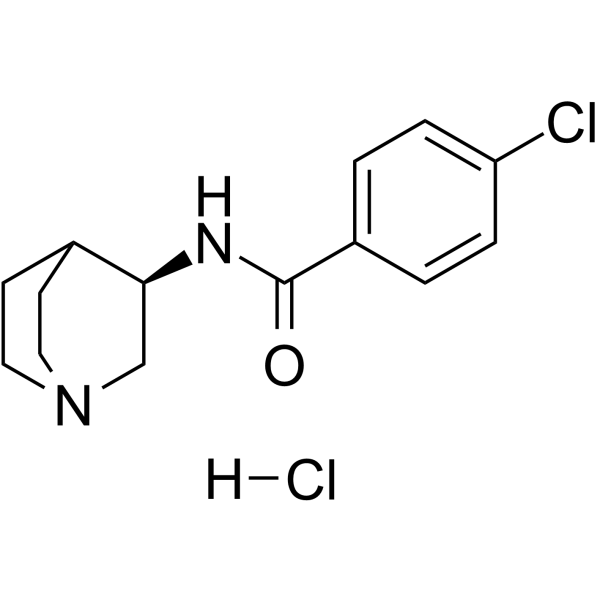
-
- HY-P1266
-
|
|
nAChR
|
Neurological Disease
|
|
α-Conotoxin EI is a selective nicotinic acetylcholine α1β1γδ receptor (nAChR) antagonist (IC50=187 nM) and an α3β4 receptor inhibitor. α-Conotoxin EI can block muscle and ganglionic receptors .
|
-
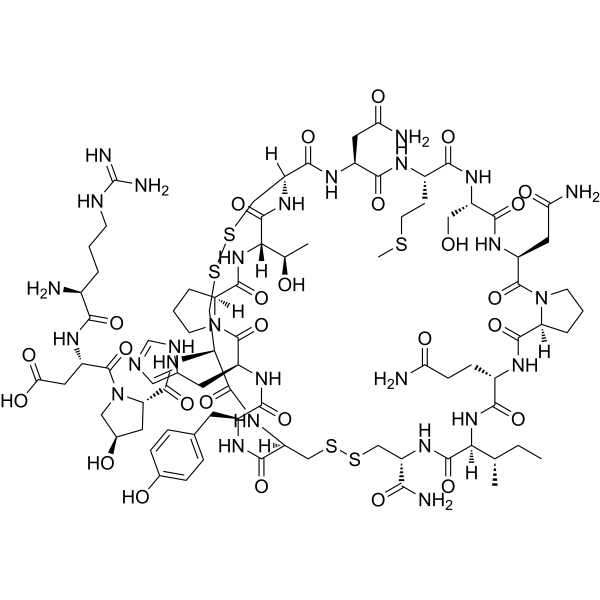
- HY-P1264
-
|
|
nAChR
|
Neurological Disease
|
|
α-Bungarotoxin is a competitive antagonist at nicotinic acetylcholine receptors (nAChRs). α-Bungarotoxin, a selective α7 receptor blocker, blocks α7 currents with an IC50 of 1.6 nM and has no effects on α3β4 currents at concentrations up to 3 μM .
|
-

- HY-P5147
-
|
|
nAChR
|
Neurological Disease
|
|
α-Conotoxin GID is a paralytic peptide neurotoxin and a selective antagonist of nAChR, with IC50s of 5 nM (α7), 3 nM (α3β2), 150 nM (α4β2), respectively. α-Conotoxin GID is small disulfide-rich peptide, with potential to inhibit chronic pain. α-Conotoxin GID contains a C-terminal carboxylate, thus substitution with a C-terminal carboxamide results in loss of α4β2 nAChR. α-Conotoxin GID can be isolated from the Conus species .
|
-
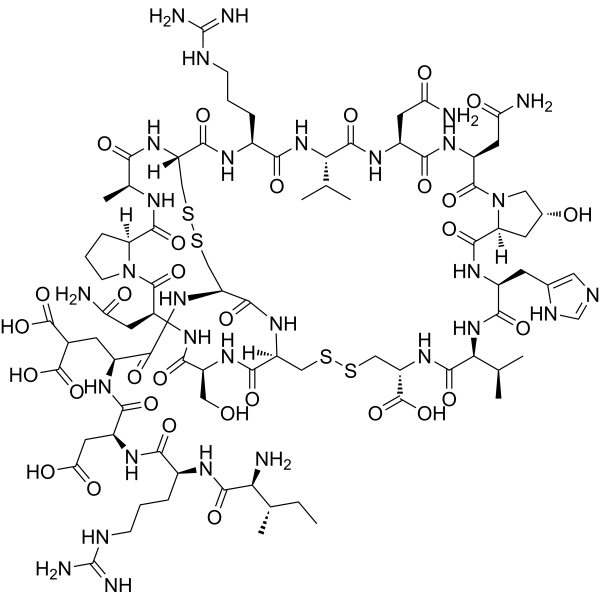
- HY-P5148
-
|
|
nAChR
|
Neurological Disease
|
|
α-Conotoxin BuIA is a paralytic peptide neurotoxin and a competitive nAChR antagonist, with IC50s of 0.258 nM (α6/α3β2), 1.54 nM (α6/α3β4), 5.72 nM (α3β2), respectively. α-Conotoxin BuIA can be used to distinguish nAChRs containing β2- and β4-subunit, respectively. α-Conotoxin BuIA distinguishes among αxβ2 nAChRs with a rank order potency of α6>α3>α2>α4 .
|
-
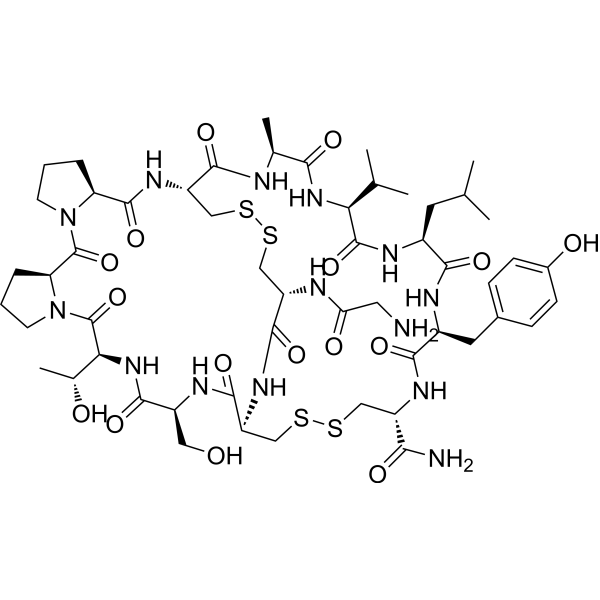
- HY-125777A
-
|
|
nAChR
|
Neurological Disease
|
|
α-Conotoxin Vc1.1 TFA is a disulfide-bonded peptide isolated from Conus victoriae and is a selective nAChR antagonist. α-Conotoxin Vc1.1 TFA inhibits α3α5β2, α3β2 and α3β4 with IC50s of 7.2 μM, 7.3 μM and 4.2 μM, respectively, and has less inhibitory effect on other nAChR subtypes. α-Conotoxin Vc1.1 TFA has the potential for neuropathic pain reserach .
|
-
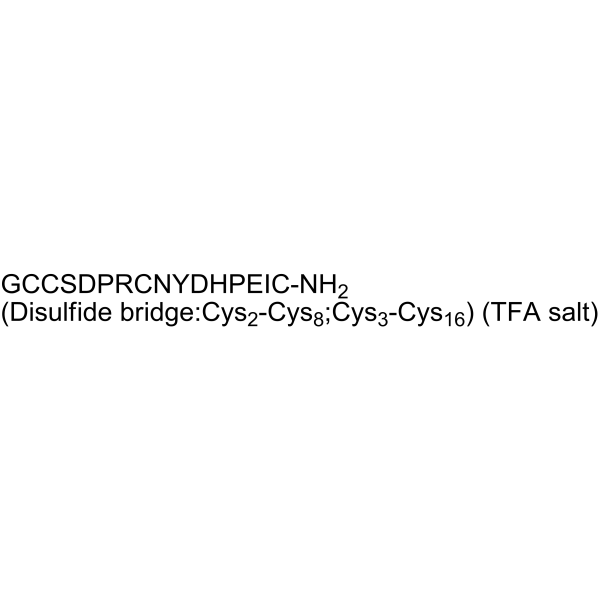
- HY-B1395S1
-
|
|
Isotope-Labeled Compounds
nAChR
|
Neurological Disease
|
|
Mecamylamine (hydrochloride)- 13C4, 15N is the 13C-labeled and 15N-labeled Mecamylamine hydrochloride. Mecamylamine hydrochloride is an orally active, nonselective, noncompetitive nAChR antagonist that can treat various neuropsychiatric disorders. Mecamylamine hydrochloride is originally used as a ganglionic blocker in treating hypertension. Mecamylamine hydrochloride can easily crosses the blood-brain barrier[1][2].
|
-
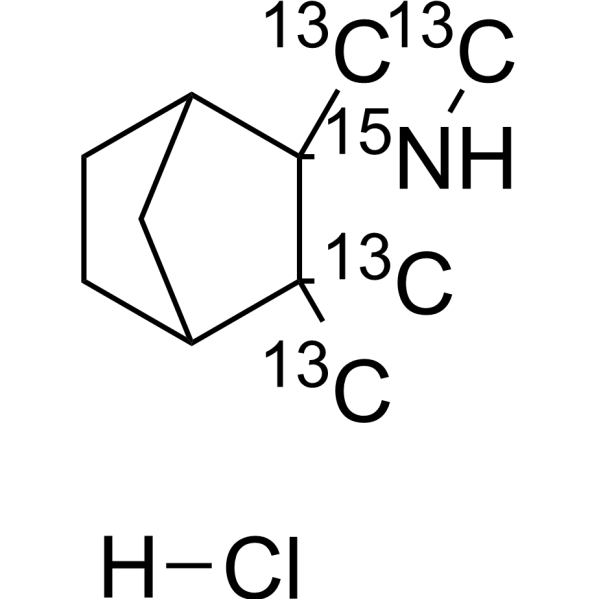
- HY-108057A
-
|
RG3487 hydrochloride
|
nAChR
5-HT Receptor
|
Neurological Disease
|
Facinicline hydrochloride (RG3487 hydrochloride) is an orally active nicotinic α7 receptor partial agonist, with a Ki of 6 nM for α7 human nAChR. Facinicline hydrochloride (RG3487 hydrochloride) improves cognition and sensorimotor gating in rodents. Facinicline hydrochloride (RG3487 hydrochloride) shows high affinity (antagonist) to 5-HT3Rs with a Ki value of 1.2 nM .
|
-

- HY-12560
-
|
|
nAChR
5-HT Receptor
|
Neurological Disease
|
|
PNU-282987 (free base) is a potent α7 nicotinic acetylcholine receptor (nAChR) agonist with an EC50 of 154 nM. PNU-282987 (free base) is also a functional antagonist of the 5-HT3 receptor with an IC50 of 4541 nM. PNU-282987 (free base) can be used for the research of central and peripheral nervous systems .
|
-
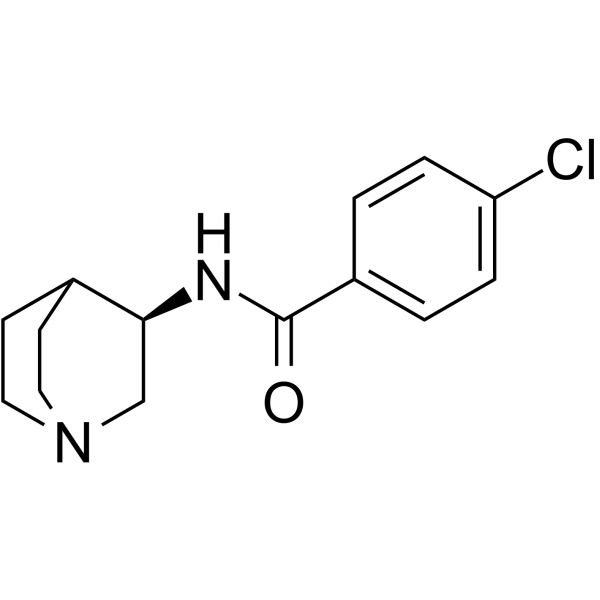
- HY-P0099
-
|
|
|
|
|
Pentapeptide-3 is a pentapeptide fragment of neurotoxin waglerin-1, it can be extracted from the venom of Temple Viper. Pentapeptide-3 is a competitive antagonist of nicotinic acetylcholine receptors (nAChRs), it can blocks nerves at the post-synaptic membrane. Pentapeptide-3 has anti-aging effects and it can be used together with other cosmetic peptides .
|
-
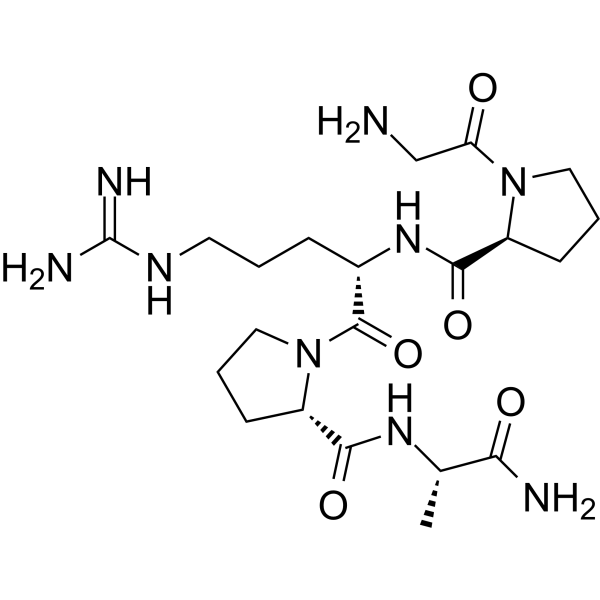
- HY-106901AS
-
|
HI-6-d4
|
Isotope-Labeled Compounds
nAChR
|
Neurological Disease
|
|
Asoxime-d4 (dichloride) is the deuterium labeled Asoxime dichloride. Asoxime dichloride (HI-6) is an antagonist to acetylcholine receptors (AChRs) including the nicotinic receptor, α7 nAChR. Asoxime dichloride involves in modulating immunity response. Asoxime dichloride (HI-6) can be used as an antigen and improves vaccination efficacy in the nervous system[1].
|
-
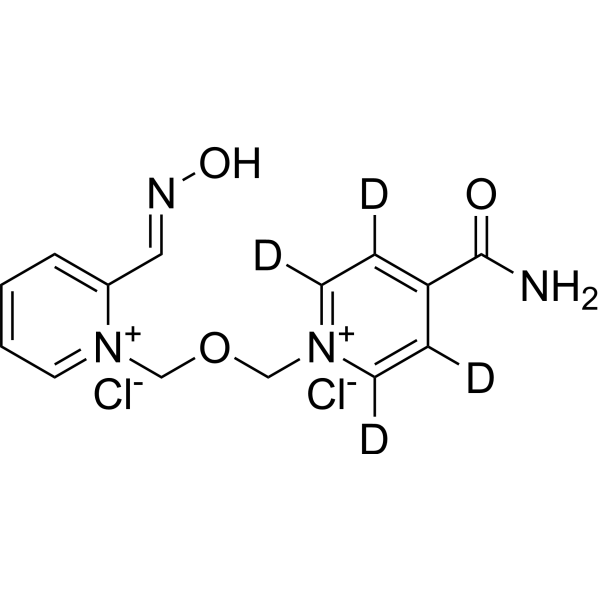
- HY-12560C
-
|
|
nAChR
5-HT Receptor
|
Neurological Disease
|
|
(S)-PNU-282987 hydrochloride is an isoform of PNU-282987 (HY-12560). PNU-282987 (free base) is a potent α7 nicotinic acetylcholine receptor (nAChR) agonist with an EC50 of 154 nM. PNU-282987 (free base) is also a functional antagonist of the 5-HT3 receptor with an IC50 of 4541 nM. PNU-282987 (free base) can be used for the research of central and peripheral nervous systems .
|
-
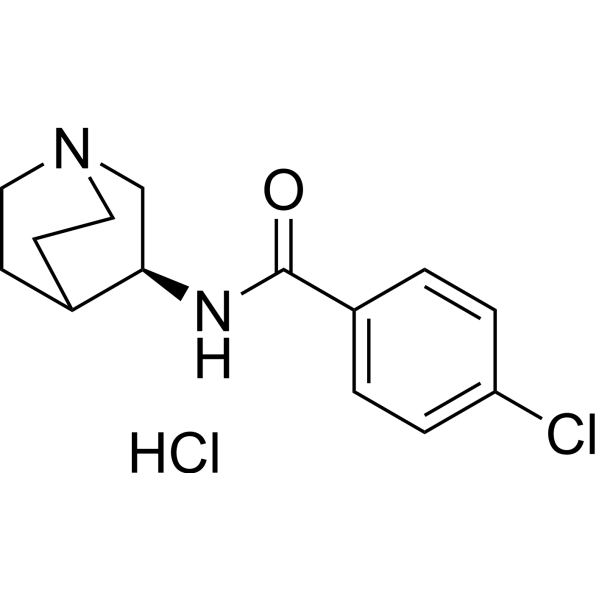
| Cat. No. |
Product Name |
Target |
Research Area |
-
- HY-P5188A
-
-
- HY-P1265
-
|
Vc1.1
|
nAChR
|
Neurological Disease
|
|
ACV1 (Vc1.1), an α-Conotoxin, is a selective α9α10 nAChR antagonist with an IC50 of 19 nM. ACV1 is ~100-fold less potent on human α9α10 vs. rat nAChRs .
|
-
- HY-P3654
-
|
|
nAChR
|
Neurological Disease
|
|
α-Conotoxin SIA is a selective nicotinic acetylcholine receptor (nAChR) antagonist with high affinity for the muscle nAChR. α-Conotoxin SIA preferentially targets the α/δ interface of the muscle nAChR in mouse muscle. In contrast, for Torpedo nAChR, α-Conotoxin SIA has a much higher affinity for the α/γ than for the α/δ interface .
|
-
- HY-P5849
-
|
αA-OIVA
|
nAChR
|
Neurological Disease
|
|
αA-Conotoxin OIVA (αA-OIVA) is a selective nAChR antagonist with an IC50 of 56 nM against mammalian fetal muscle nAChR. αA-Conotoxin OIVA is a peptide that can be derived from conotoxin. αA-Conotoxin OIVA paralyzes muscles .
|
-
- HY-P1269
-
|
|
nAChR
|
Neurological Disease
|
|
α-Conotoxin AuIB, a potent and selective α3β4 nicotinic acetylcholine receptor (nAChR) antagonist, blocks α3β4 nAChRs expressed in Xenopus oocytes with an IC50 of 0.75 μM .
|
-
- HY-P1268
-
|
|
nAChR
|
Neurological Disease
|
|
α-Conotoxin PIA is a nicotinic acetylcholine receptor (nAChR) antagonist that targets nAChR subtypes containing α6 and α3 subunits. α-Conotoxin PIA has the potential for the research of Parkinson’s disease, and schizophrenia 。
|
-
- HY-P1269A
-
|
|
nAChR
|
Neurological Disease
|
|
α-Conotoxin AuIB TFA, a potent and selective α3β4 nicotinic acetylcholine receptor (nAChR) antagonist, blocks α3β4 nAChRs expressed in Xenopus oocytes with an IC50 of 0.75 μM .
|
-
- HY-P1268A
-
|
|
nAChR
|
Neurological Disease
|
|
α-Conotoxin PIA TFA is a nicotinic acetylcholine receptor (nAChR) antagonist that targets nAChR subtypes containing α6 and α3 subunits. α-Conotoxin PIA has the potential for the research of Parkinson’s disease, and schizophrenia 。
|
-
- HY-P5149
-
|
αC-PrXA
|
nAChR
|
Neurological Disease
|
|
αC-Conotoxin PrXA is a paralytic peptide neurotoxin and a competitive nAChR antagonist, with IC50s of 1.8 nM (α1β1εδ, adult) and 3.0 nM (α1β1γδ, fetal), respectively. αC-Conotoxin PrXA competes with α-bungarotoxin at the α/δ and α/γ subunit interfaces of the nAChR, shows high specificity against neuromuscular nAChR .
|
-
- HY-P1264F
-
|
|
nAChR
|
Neurological Disease
|
|
FITC-α-Bungarotoxin is the FITC labelled α-Bungarotoxin (HY-P1264). α-Bungarotoxin is a competitive antagonist at nicotinic acetylcholine receptors (nAChRs) .
|
-
- HY-P1264F1
-
|
|
nAChR
|
Neurological Disease
|
|
Biotin-α-Bungarotoxin is the Biotin labelled α-Bungarotoxin (HY-P1264). α-Bungarotoxin is a competitive antagonist at nicotinic acetylcholine receptors (nAChRs) .
|
-
- HY-P1267
-
|
|
nAChR
|
Neurological Disease
|
|
α-Conotoxin PnIA, a potent and selective antagonist of the mammalian α7 nAChR, has the potential for the research of neurological conditions such as neuropathic pain and Alzheimer’s disease .
|
-
- HY-P1267A
-
|
|
nAChR
|
Neurological Disease
|
|
α-Conotoxin PnIA TFA, a potent and selective antagonist of the mammalian α7 nAChR, has the potential for the research of neurological conditions such as neuropathic pain and Alzheimer’s disease .
|
-
- HY-P5848
-
|
|
nAChR
|
Neurological Disease
|
|
αO-Conotoxin GeXIVA is a potent α9α10 nAChR antagonist with an IC50 of 12 nM against rat α9α10. αO-Conotoxin GeXIVA shows analgesic in animal models of pain .
|
-
- HY-P5306
-
|
|
nAChR
|
Neurological Disease
|
|
α-Conotoxin TxID is a potent α3β4 nAChR antagonist with an IC50 value of 12.5 nM. α-Conotoxin TxID has weak inhibition activity of closely related α6/α3β4 nAChR (IC50= 94 nM). α-Conotoxin TxID has the potential for novel smoking cessation drug development .
|
-
- HY-P1271
-
|
|
nAChR
|
Cardiovascular Disease
|
|
Catestatin is a 21-amino acid residue, cationic and hydrophobic peptide. Catestatin is an endogenous peptide that regulates cardiac function and blood pressure . Catestatin is a non-competitive nicotinic antagonist acting through nicotinic acetylcholine receptors (nAChRs) to inhibit catecholamine release .
|
-
- HY-P1050A
-
|
|
nAChR
|
Neurological Disease
Inflammation/Immunology
|
|
COG 133 TFA is a fragment of Apolipoprotein E (APOE) peptide. COG 133 TFA competes with the ApoE holoprotein for binding the LDL receptor, with potent anti-inflammatory and neuroprotective effects. COG 133 TFA is also a nAChR antagonist with an IC50 of 445 nM .
|
-
- HY-P1270
-
|
|
nAChR
|
Neurological Disease
|
|
α-Conotoxin Im-I is a selective α7/α9 nAChR antagonist, blocking α7 nicotinic receptors with the highest apparent affinity, while having an 8-fold lower affinity for homomeric α9 nicotinic receptors. α-Conotoxin Im-I is toxic and induces seizures in rodents. α-Conotoxin Im-I is a tool for studying neuronal nAChR .
|
-
- HY-P1271A
-
|
|
nAChR
|
Cardiovascular Disease
|
|
Catestatin TFA is a 21-amino acid residue, cationic and hydrophobic peptide. Catestatin TFA is an endogenous peptide that regulates cardiac function and blood pressure . Catestatin TFA is a non-competitive nicotinic antagonist acting through nicotinic acetylcholine receptors (nAChRs) to inhibit catecholamine release .
|
-
- HY-P5845
-
|
α-RgIA
|
nAChR
|
Neurological Disease
|
|
α-Conotoxin RgIA (α-RgIA) is a specific α9α10 nAChR antagonist. α-Conotoxin RgIA can be obtained from Conus regius venom. α-Conotoxin RgIA can be used in the study of neurological diseases .
|
-
- HY-P1266
-
|
|
nAChR
|
Neurological Disease
|
|
α-Conotoxin EI is a selective nicotinic acetylcholine α1β1γδ receptor (nAChR) antagonist (IC50=187 nM) and an α3β4 receptor inhibitor. α-Conotoxin EI can block muscle and ganglionic receptors .
|
-
- HY-P1264
-
|
|
nAChR
|
Neurological Disease
|
|
α-Bungarotoxin is a competitive antagonist at nicotinic acetylcholine receptors (nAChRs). α-Bungarotoxin, a selective α7 receptor blocker, blocks α7 currents with an IC50 of 1.6 nM and has no effects on α3β4 currents at concentrations up to 3 μM .
|
-
- HY-P5147
-
|
|
nAChR
|
Neurological Disease
|
|
α-Conotoxin GID is a paralytic peptide neurotoxin and a selective antagonist of nAChR, with IC50s of 5 nM (α7), 3 nM (α3β2), 150 nM (α4β2), respectively. α-Conotoxin GID is small disulfide-rich peptide, with potential to inhibit chronic pain. α-Conotoxin GID contains a C-terminal carboxylate, thus substitution with a C-terminal carboxamide results in loss of α4β2 nAChR. α-Conotoxin GID can be isolated from the Conus species .
|
-
- HY-P5148
-
|
|
nAChR
|
Neurological Disease
|
|
α-Conotoxin BuIA is a paralytic peptide neurotoxin and a competitive nAChR antagonist, with IC50s of 0.258 nM (α6/α3β2), 1.54 nM (α6/α3β4), 5.72 nM (α3β2), respectively. α-Conotoxin BuIA can be used to distinguish nAChRs containing β2- and β4-subunit, respectively. α-Conotoxin BuIA distinguishes among αxβ2 nAChRs with a rank order potency of α6>α3>α2>α4 .
|
-
- HY-125777A
-
|
|
nAChR
|
Neurological Disease
|
|
α-Conotoxin Vc1.1 TFA is a disulfide-bonded peptide isolated from Conus victoriae and is a selective nAChR antagonist. α-Conotoxin Vc1.1 TFA inhibits α3α5β2, α3β2 and α3β4 with IC50s of 7.2 μM, 7.3 μM and 4.2 μM, respectively, and has less inhibitory effect on other nAChR subtypes. α-Conotoxin Vc1.1 TFA has the potential for neuropathic pain reserach .
|
| Cat. No. |
Product Name |
Category |
Target |
Chemical Structure |
| Cat. No. |
Product Name |
Chemical Structure |
-
- HY-106901AS
-
|
|
|
Asoxime-d4 (dichloride) is the deuterium labeled Asoxime dichloride. Asoxime dichloride (HI-6) is an antagonist to acetylcholine receptors (AChRs) including the nicotinic receptor, α7 nAChR. Asoxime dichloride involves in modulating immunity response. Asoxime dichloride (HI-6) can be used as an antigen and improves vaccination efficacy in the nervous system[1].
|
-

-
- HY-B1395S1
-
|
|
|
Mecamylamine (hydrochloride)- 13C4, 15N is the 13C-labeled and 15N-labeled Mecamylamine hydrochloride. Mecamylamine hydrochloride is an orally active, nonselective, noncompetitive nAChR antagonist that can treat various neuropsychiatric disorders. Mecamylamine hydrochloride is originally used as a ganglionic blocker in treating hypertension. Mecamylamine hydrochloride can easily crosses the blood-brain barrier[1][2].
|
-

Your information is safe with us. * Required Fields.
Inquiry Information
- Product Name:
- Cat. No.:
- Quantity:
- MCE Japan Authorized Agent:




































































